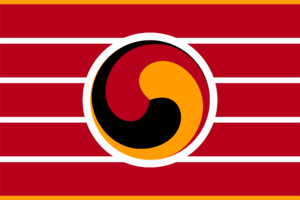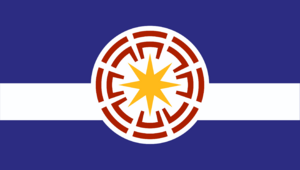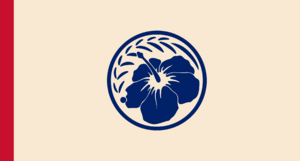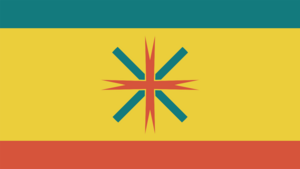Flag of Enyama
The flags of Enyama (Enyaman: 에냐마하타) consist of the national flags of the currently disputed Enyaman region. Estimates have concluded that, while over thirty flags are in use in Enyama currently, the main factions have typically only used one main flag; historical flags of Enyama have typically included the eight- or seven-pointed Star of Enyama, which is intended to represent all of the peoples of Enyama; during Muratagi Eijiro's New Frontier regime (2005-present), the star of Enyama had its Dairi point removed, illustrating the racism of Muratagi's regime.
History
Indigenous and early Colonial symbology
Tsurushimese Dominion
Republican Enyama
The North Star movement had been using star iconography since its inception in the late 1880s, but the formation of the Enyaman Federation had prompted a call for standardization. Nomekawa Skakai, an Enyaman urbanite and tailor from Shakohidaka, had proposed in a public letter that the flag have 15 stripes for the 15 federal states, with an eight-pointed star offset to the left, which each point representing a central Enyaman ethnicity: Enyamans, Tsurushimese, Dairi, Wabayan, Wiyátamánwit, Anágan, Haratago, and Elatian. The Assembly, which had been drafting the new constitution, recieved the letter and held a vote on adopting the design, which won out.
The new Enyaman flag became an iconic symbol of unity among the peoples of Enyama, being used across the entire 20th century and into 2006, when Muratagi Eijiro formally replaced the flag. Terramoto Hastian, the Enyaman President from 1895 to 1905 and father of the Nation, was quoted in 1900 as saying "This flag is not simply the flag of Revolution. That star is the beating heart of our nations - of all our peoples, together. It is much more than a statement, it is an ideal."
New Frontier flag
Following President Muratagi's reforms of the constiution towards codifying the supremacy of the Tsurushimese plurality of the south in 2006, several new flag designs were put before Parliament, of which Muratagi's own personal design was selected. Though the star iconography was maintained, it moved from an eight-pointed to a seven-pointed star, signifying the ostracization of the Dairi and related groups by the proto-Invictist New Frontier party. Analysts believed it likely at the time that Muratagi's grip had already been so tight that the competition for a new design was, in and of itself, a facade used for the excuse of introducing Muratagi's own design under the impression of continued democracy.
After the new flag's adoption, many defied Federal orders and continued to fly the old flag, including several mayors both within and outside of Norinnia. This defiance reportedly angered Muratagi enough to arrest over 500 officials in the winter of 2006-07. Today, with the collapse of the New Frontier movement, the flag has fallen into disuse, though it is still painted or plastered on many buildings, billboards, and posters from before the war.
Enyaman Civil War flags
Following the outbreak of the Enyaman Civil War and mass-mutiny of the military against the state, mass confusion in battles resulted in the swift adoption of new designs for the purpose of identifying friend and foe among the factions. For the Three Colors army, this entailed turning the mon of the Armed Forces into proper banner; this banner became the namesake of the army, with the triple tomoe of red, gold, and black. In December 2019, the newly-created Democratic Coalition created an indigo triband flag bringing back the original eight-pointed star, as well as a Wabi-sabi circle of Furózin origin, signifying unity.
Though these banners were commonplace during the early stages of the war, the emergence of new factions after the defeat of Muratagi's National State called for innovation in symbology; the Northern Democratic coalition began to use a recolored version of the Hoshímanataí in late 2020, while self-styled Shogun Banno Yudo began to use his personal mon as opposed to the flag of the Army.






